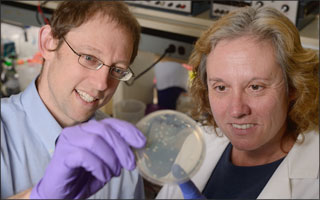Designing a complete yeast chromosome

When news came in April that a team of researchers from John Hopkins had created in a lab an entire yeast chromosome — piece by piece, gene by gene — the whole world took note. The synthesis of an entire chromosome is seen as a major step toward a future of streamlined and easily modifiable designer yeast that can be programmed to perform any number of important tasks.
“From car parts to clothing, so much around us has been synthesized through organic chemistry that we’re kind of used to it, but now we’re doing the same thing with biology. It might allow us to someday do amazing things like clean up toxic waste or improve human health,” says Joel Bader, PhD, an associate professor in the Department of Biomedical Engineering. Bader is a computational biologist who led development of the software that helped design and assemble all the various genetic pieces into a complete chromosome.
Though others have previously synthesized simpler bacteria and virus chromosomes, this was the first time anyone had synthesized an entire chromosome of the more complex forms of life — known as the eukaryotes — that include all plants, animals, and fungi.
Getting to this single chromosome was no easy task, and there is much work still ahead. The resulting paper, published in the journal Science, was the culmination of five years of work.
“My group writes software that allows researchers to edit the genome, and then the software guides the production and assembly of the pieces into a chromosome,” Bader says. He notes the software also includes stringent quality control steps.
“We don’t want any mistakes to creep in. So, after every stage there’s a check that tells us, ‘So far, so good,’” Bader says.
Not only did the team create a complete and functioning chromosome, but it is a very efficient one at that. Bader’s software helped create a chromosome with repetitious and nonfunctional sections removed. The result is a third chromosome that is actually 20 percent shorter than that of natural yeast, yet more stable.
“We’ve taken out any extraneous genetic information, removed destabilizing elements, and eliminated redundancies,” said Srinivasan Chandrasegaran, PhD, a professor in the Department of Environmental Health Sciences at the Johns Hopkins Bloomberg School of Public Health at Johns Hopkins and a senior author on the study.
“Much like a synthetic organic chemist 100 years ago would have been floored by the thought of synthesizing something like Kevlar, the benefits of biological synthesis will take shape in ways we can’t even imagine yet. This is like science fiction,” Bader says.
